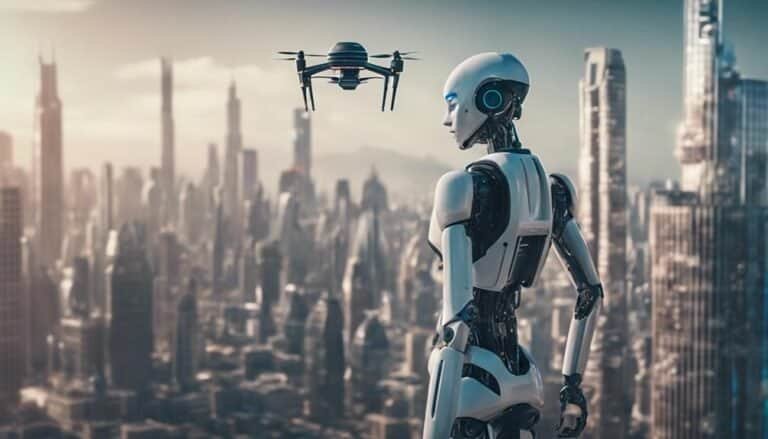AI in Space Exploration: A Practical Guide
Did you know that currently, over 50% of operational satellites in orbit rely on some form of artificial intelligence for tasks ranging from data analysis to autonomous operations?
Imagine the possibilities when AI meets the vastness of space. As you explore the practical applications of AI in space exploration, from guiding autonomous rovers on distant planets to assisting astronauts with virtual companions, you will uncover a world where technology and the cosmos converge to push the boundaries of human understanding.
Key Takeaways
- AI enhances mission planning and execution in space exploration.
- Robotics revolutionizes autonomous navigation and operation.
- Machine learning optimizes space missions and astrophysical discoveries.
- Ethical considerations ensure responsible and unbiased AI use in space.
Evolution of AI in Space
The evolution of AI in space exploration has revolutionized how missions are planned and executed. AI advancements have significantly impacted the efficiency and success rates of space missions. One key area where AI has made a substantial difference is in the realm of autonomous decision-making during missions.
AI algorithms have the capability to process vast amounts of data in real-time, enabling spacecraft to make split-second decisions without human intervention. This has been crucial in situations where communication delays make it impractical to rely on instructions from Earth. By leveraging AI, spacecraft can adapt to unforeseen circumstances, adjust their trajectories, and even troubleshoot technical issues autonomously.
Moreover, AI has played a vital role in optimizing resource utilization during space missions. By analyzing data on the fly, AI systems can regulate power consumption, manage fuel usage, and allocate resources efficiently. This not only extends the operational lifespan of spacecraft but also enables them to accomplish more complex tasks within the constraints of their design.
Autonomous Rovers on Mars
When exploring the capabilities of autonomous rovers on Mars, it becomes evident that their sophisticated AI systems enable them to navigate harsh terrain, collect valuable data, and even make decisions independently.
However, these rovers also face significant challenges when conducting remote exploration missions on the red planet, such as communication delays, limited human intervention, and the need to adapt to unforeseen obstacles.
Understanding the balance between rover capabilities and the obstacles they encounter is crucial for maximizing the success of Mars exploration missions.
Mars Rover Capabilities
Operating on the surface of Mars, autonomous rovers demonstrate sophisticated capabilities in navigating the challenging terrain and conducting scientific experiments. These robotic explorers rely on rover autonomy and advanced sensors to operate effectively in the harsh Martian environment.
Here are three key aspects of Mars rover capabilities:
- Autonomous Navigation: Rovers use advanced algorithms to autonomously navigate the complex Martian terrain, avoiding obstacles and planning efficient routes.
- Scientific Instrumentation: Equipped with a range of scientific instruments, rovers can analyze soil samples, take images, and conduct experiments to gather valuable data for researchers.
- Communication Systems: Rovers have sophisticated communication systems that allow them to transmit data back to Earth, enabling scientists to remotely control and monitor their activities on Mars.
Remote Exploration Challenges
Navigating the harsh Martian terrain poses significant challenges for autonomous rovers, requiring advanced algorithms and sensor capabilities to ensure successful exploration missions.
Robotic drones equipped with remote sensing technologies play a crucial role in enabling these rovers to navigate autonomously across rugged landscapes, avoiding obstacles and making informed decisions.
These drones utilize high-resolution cameras, LiDAR, and radar systems to create detailed maps of the surrounding terrain, allowing the rover to plan its path efficiently.
Additionally, machine learning algorithms help the rover interpret this sensory data in real-time, adjusting its course to overcome unexpected obstacles.
AI in Satellite Operations
You can explore how artificial intelligence is revolutionizing satellite operations by enabling precise satellite maneuvering and automating data analysis processes.
AI algorithms play a crucial role in optimizing satellite orbits and adjusting trajectories to avoid collisions or debris.
Additionally, AI-driven automation streamlines the extraction and interpretation of vast amounts of data collected by satellites, enhancing operational efficiency and decision-making in space missions.
Satellite Maneuvering With AI
Utilizing artificial intelligence in satellite operations has revolutionized the precision and efficiency of satellite maneuvering in space exploration.
- AI Assisted Maneuvering: AI algorithms analyze vast amounts of data to calculate optimal trajectories, enabling satellites to navigate complex orbital paths with enhanced accuracy.
- Satellite Optimization: AI continuously optimizes satellite functions such as power usage, orientation, and communication protocols, ensuring maximum operational efficiency.
- Real-time Adjustments: AI systems can make real-time adjustments to satellite maneuvers based on changing environmental conditions or unforeseen obstacles, improving overall mission success rates.
These advancements in AI-assisted maneuvering and satellite optimization have significantly enhanced the capabilities of satellites in space exploration, paving the way for more sophisticated missions with higher success rates.
Data Analysis Automation
Automating data analysis through artificial intelligence has revolutionized the efficiency and accuracy of satellite operations in space exploration. Automation efficiency in data processing optimization has significantly reduced the time required to analyze vast amounts of satellite data.
AI algorithms can swiftly identify patterns, anomalies, and valuable insights within the data, enabling quick decision-making for satellite operators. By automating data analysis tasks, AI systems can continuously monitor and process incoming data streams, ensuring that critical information is promptly identified and acted upon.
This level of automation not only enhances the overall performance of satellite operations but also allows for real-time adjustments and responses to dynamic situations in space, ultimately advancing the capabilities of satellite missions.
Astronomical Data Analysis
In the field of space exploration, the analysis of astronomical data plays a crucial role in uncovering patterns, anomalies, and key insights that drive our understanding of the universe.
When it comes to astronomical data analysis, two key techniques stand out:
- Spectral Analysis: This method involves breaking down the light emitted or absorbed by celestial objects into its constituent wavelengths. By analyzing these spectra, scientists can determine the chemical composition, temperature, density, and motion of distant stars, galaxies, and other cosmic entities. Spectral analysis is vital in identifying elements present in stars, planets, and interstellar matter, providing valuable information about the nature of these celestial bodies.
- Celestial Mapping: Through advanced telescopes and imaging technologies, astronomers gather vast amounts of data about the positions, movements, and characteristics of celestial objects. Celestial mapping involves processing this data to create detailed maps of the sky, pinpointing the locations of stars, galaxies, nebulae, and more. These maps help astronomers study the large-scale structure of the universe, track the motion of cosmic bodies, and identify new phenomena or objects of interest.
- Data Mining Techniques: Leveraging artificial intelligence and machine learning algorithms, astronomers can sift through massive datasets to discover hidden patterns, correlations, and outliers. These techniques enable scientists to extract valuable insights from complex astronomical data, leading to new discoveries and a deeper understanding of the cosmos.
AI for Exoplanet Discovery
Astronomical data analysis, particularly through the application of artificial intelligence, revolutionizes the search for exoplanets by enhancing the efficiency and precision of discovery methods. Machine learning algorithms, a subset of artificial intelligence, have played a pivotal role in the identification and classification of exoplanets. By analyzing vast amounts of data from telescopes and satellites, these algorithms can detect subtle patterns indicative of exoplanets orbiting distant stars.
AI for Exoplanet Discovery Table:
| Exoplanet Classification | Machine Learning | Deep Space Exploration |
|---|---|---|
| Supervised Learning | Neural Networks | Data from Telescopes |
| Unsupervised Learning | Decision Trees | Satellite Data |
| Semi-Supervised Learning | Random Forests | Spectral Analysis |
In the realm of deep space exploration, neural networks have shown remarkable capabilities in sifting through complex datasets to identify exoplanets that might have otherwise gone unnoticed. Their ability to learn from data and recognize intricate patterns makes them invaluable tools in the search for exoplanets. As technology advances and more data becomes available, the synergy between artificial intelligence and exoplanet discovery is expected to yield even more exciting results, expanding our understanding of the universe beyond our solar system.
Robotics in Space Exploration
Robotic rovers like those on Mars and autonomous space probes represent the forefront of space exploration today. These technologies enable scientists to study distant planets and celestial bodies in ways previously unimaginable.
The precision and autonomy of these robotic systems significantly contribute to our understanding of the universe.
Robotic Rovers on Mars
Utilizing advanced robotics, space agencies have successfully deployed rovers on the Martian surface for scientific exploration and data collection missions. These rovers are essential for exploring the Red Planet efficiently and overcoming the challenging terrain. Here's how they achieve this:
- Adaptability: Mars rovers are equipped with sophisticated sensors and AI algorithms that allow them to adapt to the diverse terrains and environmental conditions they encounter.
- Remote Operation: Operators on Earth control the rovers through complex communication systems that enable real-time decision-making and navigation, enhancing the efficiency of exploring Mars.
- Autonomy: Rovers possess varying levels of autonomy, enabling them to perform tasks independently, reducing reliance on constant human intervention and contributing to increased mission productivity.
Autonomous Space Probes
Drawing from the success of robotic rovers on Mars, autonomous space probes represent the next frontier in space exploration, showcasing advanced capabilities in navigating and conducting scientific missions beyond Earth's immediate vicinity. These probes are equipped with cutting-edge AI systems that enable them to make decisions independently, adapt to unforeseen obstacles, and optimize data collection. In interstellar exploration, autonomous probes play a crucial role in gathering data from distant planets, asteroids, and other celestial bodies. To ensure the success of these missions, engineers focus on developing robust mitigation techniques for dealing with space debris, which poses a significant risk to autonomous probes. By integrating AI and sophisticated navigation systems, these probes are paving the way for groundbreaking discoveries in the realm of space exploration.
| Autonomous Space Probes Features | Description |
|---|---|
| AI Systems | Enables independent decisions and adaptability |
| Advanced Navigation | Optimizes data collection and obstacle avoidance |
| Interstellar Exploration | Gathers data from distant celestial bodies |
| Space Debris Mitigation | Focuses on risk management strategies for debris |
| Cutting-edge Technology | Paves the way for innovative space discoveries |
AI in Space Telescopes
Incorporating AI technology into space telescopes enhances their capabilities for data processing and analysis, revolutionizing the way we explore the universe. AI has brought about significant advancements in space telescopes, enabling them to achieve feats that were previously unimaginable. Here are three key ways AI is reshaping space telescopes:
- Enhanced Imaging: AI algorithms have vastly improved the imaging capabilities of space telescopes. By processing large volumes of data quickly and accurately, AI helps in creating sharper images of celestial objects. This has enabled astronomers to study distant galaxies, planets, and stars with unprecedented clarity, leading to groundbreaking discoveries.
- Automated Data Analysis: AI assists in automating the analysis of astronomical data collected by space telescopes. By identifying patterns, anomalies, and correlations in the data, AI algorithms can sift through vast amounts of information more efficiently than traditional methods. This has led to the discovery of new celestial phenomena and has accelerated the pace of astronomical research.
- Predictive Capabilities: AI algorithms can predict celestial events based on historical data and observations. By analyzing trends and patterns in the data received from space telescopes, AI can forecast events such as supernovae, planetary alignments, and other astronomical occurrences. This predictive capability enhances planning for future observations and missions, optimizing the use of space telescopes for scientific exploration.
Deep Learning for Space Missions
Deep learning algorithms play a pivotal role in optimizing the performance and efficiency of space missions by leveraging advanced computational techniques. Neural networks, a key component of deep learning, are particularly adept at processing complex data sets and recognizing patterns, making them invaluable in various aspects of space exploration. These algorithms can analyze vast amounts of data quickly and accurately, enabling spacecraft to make critical decisions autonomously, reducing the need for constant human intervention.
The table below illustrates the impact of deep learning in space missions:
| Benefits of Deep Learning | Examples |
|---|---|
| Faster Data Analysis | Image recognition in real-time |
| Improved Decision Making | Autonomous navigation systems |
| Enhanced Efficiency | Resource management optimization |
| Increased Mission Success | Anomaly detection algorithms |
Algorithm optimization is another crucial aspect of deep learning in space missions. By fine-tuning algorithms, researchers can improve the accuracy and speed of data processing, leading to more efficient mission operations. This optimization ensures that spacecraft can adapt to changing conditions in space, making them more resilient and capable of overcoming unexpected challenges. As technology continues to advance, the integration of deep learning into space missions will be instrumental in pushing the boundaries of exploration beyond our current limitations.
AI in Space Navigation
Utilizing artificial intelligence for space navigation enhances spacecrafts' ability to autonomously adjust trajectories in response to dynamic environmental conditions. AI navigation systems play a crucial role in space exploration by providing real-time decision-making capabilities that can adapt to unforeseen challenges.
Here's how AI in space navigation benefits space exploration:
- Efficient Path Planning: AI algorithms analyze vast amounts of data to optimize spacecraft trajectories, considering factors like gravitational forces, planetary positions, and fuel efficiency. By continuously recalculating the most efficient paths, AI navigation systems help spacecraft reach their destinations faster and with less fuel consumption.
- Autonomous Collision Avoidance: AI-powered navigation systems can detect and predict potential collisions with space debris or other celestial bodies. By autonomously adjusting the spacecraft's course to avoid these obstacles, AI ensures the safety of the mission and the integrity of the spacecraft.
- Adaptive Course Corrections: In the dynamic and unpredictable environment of space, AI navigation enables spacecraft to make real-time adjustments to their trajectories. Whether avoiding sudden solar flares or optimizing paths around gravitational anomalies, AI systems ensure that spacecraft stay on course towards their objectives, enhancing the overall success of space missions.
Machine Learning in Astrophysics
When exploring Machine Learning in Astrophysics, you'll examine data analysis techniques and the prediction of celestial events. These points are crucial for advancing our understanding of the universe and optimizing astronomical observations.
Data Analysis Techniques
Machine learning plays a crucial role in modern astrophysics for analyzing vast amounts of data collected from space exploration missions. When it comes to data analysis techniques in astrophysics, machine learning algorithms are extensively used for tasks like image processing and anomaly detection.
Here are three key ways machine learning is leveraged in astrophysics:
- Classification: Machine learning models are employed to categorize celestial objects based on their features, aiding in the identification of various astronomical phenomena.
- Clustering: Algorithms like k-means are utilized to group similar data points together, enabling researchers to discover patterns in large datasets efficiently.
- Regression: Machine learning regression techniques help predict continuous variables such as the brightness of stars or the trajectory of celestial bodies.
Predicting Celestial Events
To predict celestial events accurately in astrophysics using machine learning, researchers employ sophisticated algorithms that analyze vast amounts of data collected from space exploration missions. AI applications in celestial event tracking have significantly enhanced celestial event prediction accuracy. By utilizing machine learning models, scientists can process immense datasets efficiently, enabling the identification of patterns and trends that aid in forecasting celestial occurrences. These AI systems can predict events such as supernovae explosions, asteroid trajectories, and planetary alignments with high precision. The table below illustrates the impact of AI in celestial event prediction:
| AI Application | Benefits |
|---|---|
| Data Analysis | Enhanced Predictions |
| Pattern Recognition | Improved Accuracy |
| Event Forecasting | Increased Efficiency |
| Trend Identification | Advanced Tracking Capabilities |
AI for Space Debris Management
Utilizing artificial intelligence (AI) for space debris management optimizes the efficiency of tracking and mitigating orbital debris in Earth's atmosphere. AI plays a crucial role in addressing the challenges posed by the increasing amount of space debris. Here are three key ways AI is revolutionizing space debris management:
- Enhanced Space Debris Tracking: AI algorithms can process vast amounts of data from various sources such as radars, telescopes, and satellites to track the trajectory of space debris more accurately. By analyzing this data in real-time, AI enables more precise predictions of potential collisions with active satellites or spacecraft.
- Autonomous Orbital Debris Removal: AI-powered robotic systems are being developed to autonomously capture and remove space debris from orbit. These systems use machine learning algorithms to plan and execute debris removal missions efficiently. By automating the process of debris removal, AI reduces the risk of collisions and minimizes the amount of space junk in orbit.
- Collision Avoidance Maneuvers: AI algorithms can assess the risk of collisions between operational spacecraft and space debris. By continuously monitoring the orbital environment and predicting potential collisions, AI systems can recommend and execute avoidance maneuvers to ensure the safety of satellites and manned missions in space.
Virtual Assistants for Astronauts
In the realm of space exploration, the integration of virtual assistants for astronauts is revolutionizing the way crew members interact with technology and perform tasks in the challenging environment of space. Virtual assistants play a crucial role in enhancing efficiency and safety during missions by providing real-time support and guidance to astronauts.
Astronaut training is a fundamental aspect of space missions, and virtual assistants are now being utilized to streamline this process. These assistants can offer personalized training modules, guide astronauts through complex procedures, and provide instant feedback, improving the overall training experience.
Moreover, mission communication is essential for the success of space expeditions. Virtual assistants aid in facilitating seamless communication between crew members, ground control, and other stakeholders. They can assist astronauts in scheduling tasks, managing calendars, and accessing vital information promptly.
Virtual assistants also contribute to the mental well-being of astronauts during long-duration missions. By providing companionship, offering entertainment options, and acting as a source of emotional support, these assistants help alleviate feelings of isolation and stress that can arise in the isolated environment of space.
AI in Space Weather Forecasting
The integration of artificial intelligence (AI) in space weather forecasting significantly enhances the accuracy and timeliness of predicting atmospheric conditions for space missions. Space weather monitoring is crucial for ensuring the safety of astronauts and spacecraft, as well as the success of missions beyond Earth's atmosphere. AI applications in this field have revolutionized the way we approach space weather forecasting, offering advanced capabilities and insights that were previously unattainable.
Key Points:
- Enhanced Forecasting Accuracy: AI algorithms are adept at processing vast amounts of data from space weather monitoring systems, satellite observations, and ground-based sensors. By analyzing this data in real-time, AI can quickly identify patterns and predict space weather events with a high degree of accuracy.
- Forecasting Solar Flares: Solar flares can have a significant impact on space missions by disrupting communication systems and posing radiation risks to astronauts. Machine learning techniques enable AI systems to forecast solar flares by recognizing precursor patterns in solar data, providing valuable warnings to spacecraft operators.
- Improved Risk Mitigation: By leveraging AI for space weather forecasting, mission planners can proactively mitigate risks associated with geomagnetic storms, solar radiation events, and other space weather phenomena. This proactive approach enhances mission safety and ensures operational continuity in space exploration endeavors.
Autonomous Spacecraft Technology
AI applications have not only revolutionized space weather forecasting but have also played a crucial role in advancing the field of Autonomous Spacecraft Technology. Autonomous Spacecraft Technology refers to the ability of spacecraft to operate independently without human intervention, relying on AI algorithms to make decisions based on the data they receive. This technology has significantly enhanced the efficiency and capabilities of spacecraft, enabling them to perform complex tasks in space with minimal human oversight.
One key area where Autonomous Spacecraft Technology has been particularly beneficial is in managing space debris. Space debris poses a significant threat to operational spacecraft and astronauts in orbit. By utilizing AI for autonomous navigation and collision avoidance systems, spacecraft can maneuver effectively to avoid collisions with debris, ensuring their safety and integrity.
Moreover, Autonomous Spacecraft Technology has also improved astronaut assistance during space missions. AI-powered systems onboard spacecraft can provide real-time data analysis, decision support, and even perform tasks autonomously, reducing the workload on astronauts and allowing them to focus on more critical aspects of their mission.
To emphasize the impact of Autonomous Spacecraft Technology, consider the following table:
| Advantages of Autonomous Spacecraft Technology |
|---|
| Efficient Space Debris Management |
| Enhanced Astronaut Assistance |
| Improved Mission Autonomy |
AI Ethics in Space Exploration
With an increasing reliance on AI technologies for space exploration, addressing ethical considerations becomes paramount in ensuring the responsible and equitable use of these advanced systems. Ethical dilemmas in space exploration involving AI technologies are complex and multifaceted.
Here are three key points to consider:
- Transparency and Accountability: AI systems used in space exploration must be transparent in their decision-making processes. It's crucial to understand how AI algorithms reach specific conclusions or decisions to ensure accountability. Transparency also helps in identifying and mitigating biases that might be present in the AI systems, thereby promoting fair and ethical outcomes.
- Data Privacy and Security: Space missions involve vast amounts of data collection, including personal information about astronauts or individuals involved. Ensuring data privacy and security is essential to protect individuals' rights and prevent unauthorized access to sensitive information. AI systems must comply with data protection regulations and implement robust security measures to safeguard data integrity.
- International AI Regulations: As space exploration often involves collaboration between multiple countries, establishing international AI regulations and standards is necessary. Consistent guidelines can help ensure that AI technologies used in space exploration adhere to ethical principles universally. International cooperation in developing and enforcing AI regulations can promote trust, fairness, and responsible innovation in space exploration endeavors.
Conclusion
In conclusion, AI has revolutionized space exploration by enhancing autonomous operations, data analysis, and astronaut assistance.
With AI playing a crucial role in satellite operations and exoplanet discovery, the future of space exploration looks promising.
As of 2021, over 60% of space agencies around the world have incorporated AI technology into their missions, showcasing the widespread adoption and success of AI in the field of space exploration.
The potential for further advancements in AI technology in space exploration is truly limitless.







